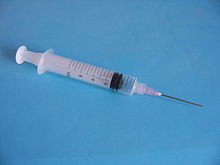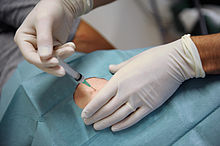
Back Ixaringa AN محقنة Arabic Şprits Azerbaijani Hiringgilya BCL Шпрыц Byelorussian Спринцовка Bulgarian সিরিঞ্জ Bengali/Bangla Strinkell Breton Xeringa Catalan Injekční stříkačka Czech
| Syringe | |
|---|---|
 A typical plastic medical syringe fitted with a detachable stainless steel needle; the syringe is fitted with a male Luer lock fitting which the needle, which is equipped with a female Luer-Lock fitting (purple), screws into | |
| Classification | Medical device |
| Industry | Healthcare |
| Application | Injection |
| Inventor | Charles Pravaz (screw) Alexander Wood (plunger) |
| Invented | 1853 |


A syringe is a simple reciprocating pump consisting of a plunger (though in modern syringes, it is actually a piston) that fits tightly within a cylindrical tube called a barrel. The plunger can be linearly pulled and pushed along the inside of the tube, allowing the syringe to take in and expel liquid or gas through a discharge orifice at the front (open) end of the tube. The open end of the syringe may be fitted with a hypodermic needle, a nozzle or tubing to direct the flow into and out of the barrel. Syringes are frequently used in clinical medicine to administer injections, infuse intravenous therapy into the bloodstream, apply compounds such as glue or lubricant, and draw/measure liquids. There are also prefilled syringes (disposable syringes marketed with liquid inside).
The word "syringe" is derived from the Greek σῦριγξ (syrinx, meaning "Pan flute", "tube").
- ^ (in French) Swiss Telegraphic Agency, "Deux millions de personnes contaminées lors d'une injection à risque en 2014" Archived 2015-04-28 at the Wayback Machine, Radio télévision suisse, 23 February 2015 (page visited on 23 February 2015).